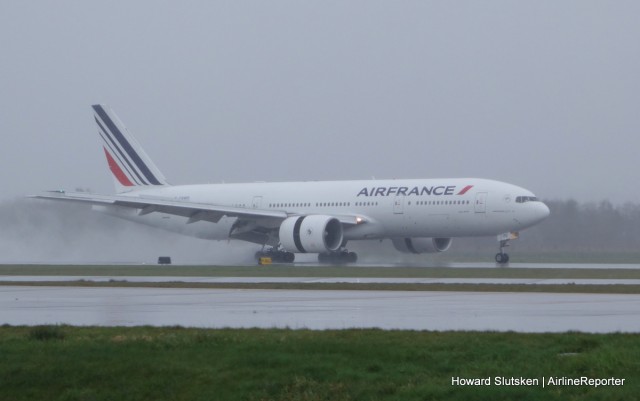
Air France’s inaugural Paris to Vancouver flight touches down on YVR’s Rwy 08L, just after noon on a rainy Sunday
C’est magnifique! Air France’s first flight to Vancouver International Airport (YVR) touched down in a huge spray of water on a soggy Sunday afternoon. The Boeing 777-200ER landed on YVR’s Runway 08L, after a nearly ten-hour flight from Paris ’“ Charles de Gaulle Airport (CDG).
This inaugural flight ran a bit late, arriving at 12:04 PM. The normal schedule has Flight AF374 departing CDG at 10:35 AM, arriving YVR at 11:50 AM, the same day. The return flight, Flight AF379, leaves YVR at 1:55 PM, and arrives CDG at 8:35 AM the following morning.
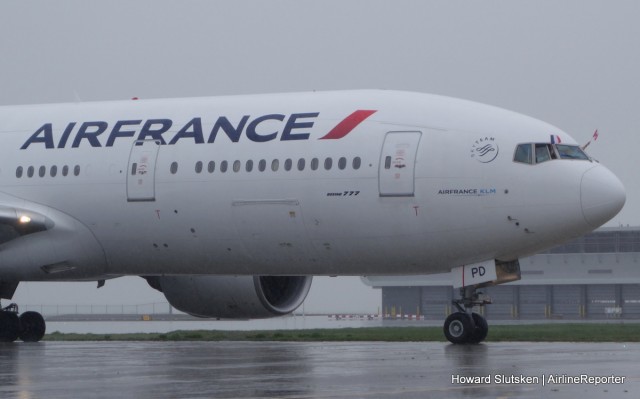
Flags flying from the cockpit, AF374 taxiies to the gate at YVR
After touchdown, the 777 received a special escort by YVR’s emergency services along Taxiway Mike, before having the traditional “new airline water cannon salute” from two fire trucks. Mind you, with the monsoon-like rain, it was tough to see the water arch!
Then, with Canadian and French flags flying from the cockpit windows, AF374 taxiied to Gate 65 at YVR’s International Terminal.
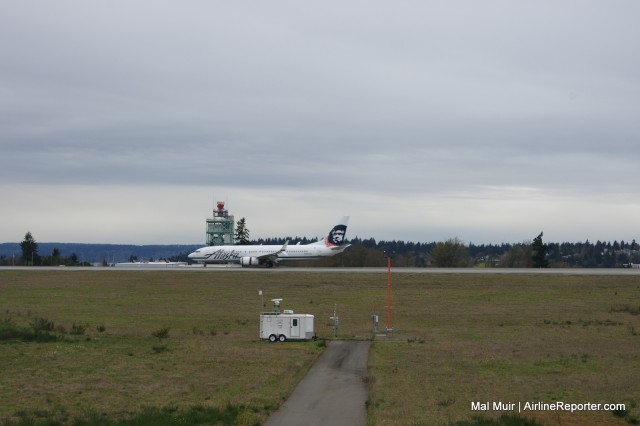
One of two avian radars located at SEA. This one is in a ditch adjacent to the third runway.
Have you ever looked up in the sky, seen a hawk or eagle soaring, and admired the beauty? Although exciting, the birds can cause major problems for aviation.
The ’œMiracle on the Hudson’ is a prime example of why birds and aircraft do not mix. But what do airports do to ensure that our journeys, from one airport to the next, are safe? I recently took a tour of Seattle-Tacoma International Airport (SEA) and saw what their wildlife management team was doing to keep both airplanes and birds safe.
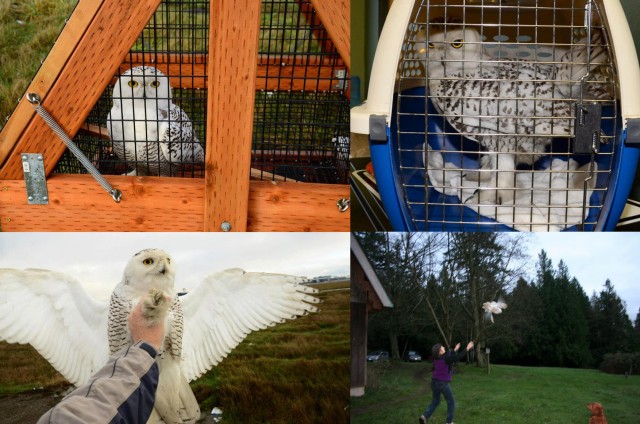
A Snowy Owl is captured at SEA, then released in the upper part of Washington state, near Bellingham – Photo: SEA
SEA has been a leader in wildlife management since the 1970s, when they were the first airport to hire a dedicated wildlife biologist onto their staff. At the moment, Steve Osmek runs the wildlife program at the airport and has done so for a number of years. Previously coming from the USDA and NOAA, he gets to combine his love of animals and an interest in aviation into on job. It was Steve who took me around the airport and introduced me to a number of ways that the airport is helping to mitigate bird strikes.
I recently had the opportunity to attend a pre-release screening of National Geographic’s new IMAX film, ’œLiving in the Age of Airplanes.’ I first saw the trailer last fall and was immediately excited to see it. Being the aviation geek that I am, I held high expectations, and I’m happy to be able to say they were met.
The project was produced and directed by Brian J. Terwilliger, who is also known for the aviation film “One Six Right.” The runtime of the show was 47 minutes, and the producers maximized every minute with absolutely stunning cinematography, paired with majestic music tracks by Oscar-winning composer James Horner and narration by Harrison Ford. The show opened in the famous ’œAirplane Graveyard’ in Mojave, California, with sad, parted-out 747s as Ford spoke about how air travel is now taken for granted.
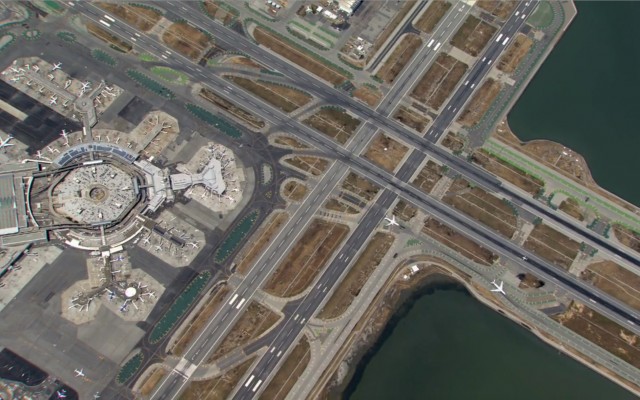
Next, we are taken down a timeline of human transportation. Beginning 200,000 years ago, humans had only one mode of transportation – our own two feet. Then roughly 5,000 years ago, the wheel was invented, and we began having animals pull us along. Fast-forward to the 1600s, when sailing ships took us across the seas and expanded our globe. In the 1800s, steam trains, and later, steam ships, propeller planes, and finally, the Jet Age.

Fresh mini pretzels await packaging
King Nut and Summer Harvest: If you’ve ever enjoyed an airline snack at 35,000 feet and inspected the wrapper, chances are you are familiar with one, or both, of these name brands. They, alongside Peterson Nut Co., make up the King Nut Companies family. As a fan of the airline industry, and the companies that support it, I’ve long been familiar with King Nut, and have spotted their products on numerous airlines. Plus, here at AirlineReporter, we love telling the behind-the-scenes stories of the airline world.
A few years back, I was excited to learn that they sometimes sell direct to the public the same airline-branded snacks I’ve come to know, love, and expect up in the air. I’ve made it a habit to occasionally place orders with them online in order to bring AvGeek-themed snacks to various gatherings; we even had their product at my son’s airline-themed birthday party.
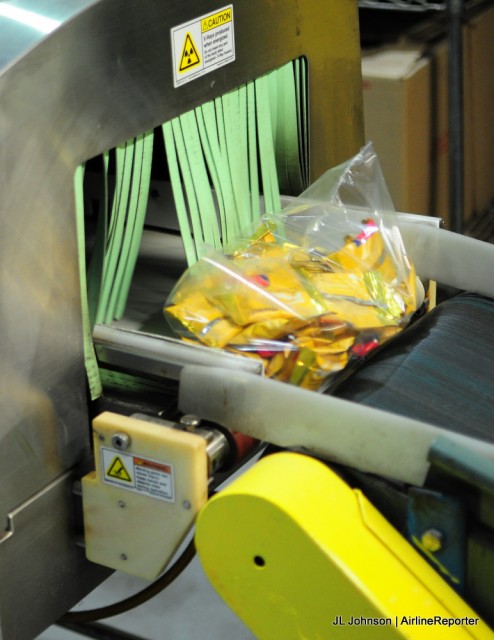
A sack of honey roasted peanuts passes through an X-ray machine
I guess you could say I’m nuts for King Nut (you knew at some point I had to make that joke – figured I should get it out of the way). And while I’m a fan of their products, I never took the time to really learn about what it takes to get these snacks into the hands (and bellies) of passengers.
That opportunity presented itself recently, when I was in the Cleveland area on business. It just so happens that the King Nut facilities are less than a mile from one of my company’s offices in Solon, Ohio. I reached out to Mr. Martin Kanan, President and Chief Executive Officer, to see about a tour and for a chance to learn about their company – he was happy to do so. Sit back, relax, grab some snacks, and prepare to drool over some seriously tasty snackage photos and facts’¦
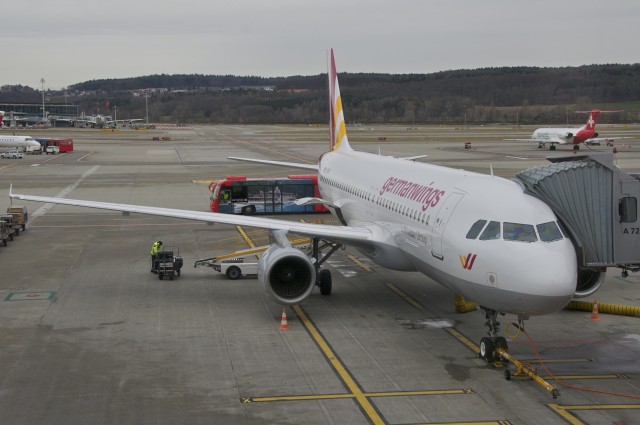
This is the Germanwings Airbus A320 (D-AIPX) involved in the crash, seen on 3/14/15 at Zurich Airport – Photo: Aero Icarus | Flickr CC
Today, a Germanwings Airbus A320 (registration D-AIPX) crashed in the Alps in southeastern France. The aircraft was carrying 144 passengers and six crew members and there are no survivors. The flight left at about 10:01am local time from Barcelona and was on its way to Dusseldorf. The crash happened near the village of Prads-Haute-Bleaone, at an altitude of about 6,550 feet. The search will be difficult, since the plane crashed in a remote, mountainous area.
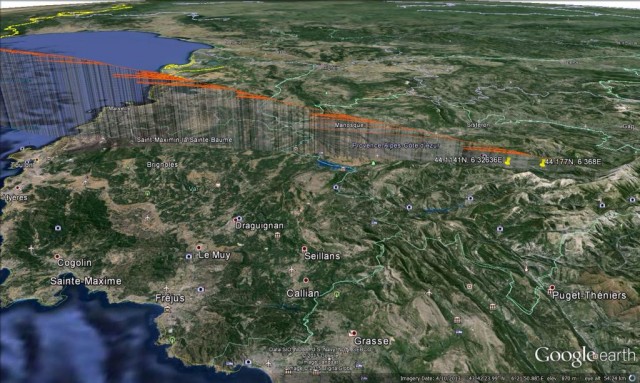
The descent of flight 9525 – Image: Google Earth | @GueardedDon
According to FlightAware, it appears that flight 9525 descended in a controlled manner from 38,000 feet at 1500 to 4000 fpm. The aircraft hit cruise altitude at about 10:45am and then started descent at 10:46am and lost contact with Air Traffic Control (ATC) at about 10:53am.








